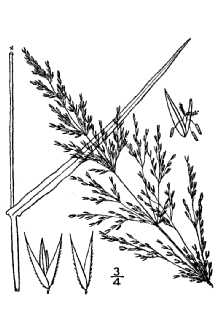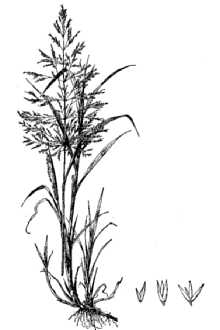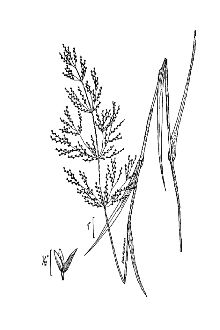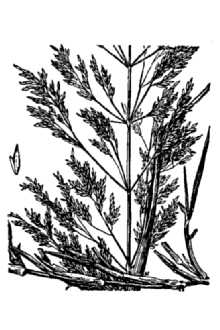Redtop
Scientific Name: Agrostis gigantea Roth

| General Information | |
|---|---|
| Usda Symbol | AGGI2 |
| Group | Monocot |
| Life Cycle | Perennial |
| Growth Habits | Graminoid |
| Native Locations | AGGI2 |
Plant Guide
Alternate Names
Agrostis alba auct. Non. L. Agrostis depressa Vassey Agrostis palustris Huds. Agrostis stolonifera L. var. major (Gaudin) Farw. Black bent Carpet bentgrass Redtop bent Redtop bentgrass Redtop has undergone numerous name changes over time, and the actual placement of the multiple species and varieties remains confused due to hybridization. Linnaeus apparently based the original description of Agrostis alba on a specimen of Poa nemoralis (Hitchcock, 1971). Historically, several varieties have been described, yet other authors have combined A. gigantea under a broader A. stolonifera (creeping bentgrass) (Cronquist et al., 1977). Currently the PLANTS database recognizes A. gigantea as a separate species from A. stolonifera with A. gigantea being primarily rhizomatous while A. stolonifera typically produces stolons. This plant guide addresses A. gigantea in the broad sense which includes earlier treatments of A. stolonifera var. major.
Uses
Livestock: Cattle prefer nearly all other cultivated grasses to redtop. It remains green summer long and is useful in western states in pasture plantings in mountain meadows. It is considered preferred feed for cattle and horses in spring and summer and a desirable feed in fall and winter. It is considered a preferred feed for sheep in spring and a desirable feed in summer (Ogle and Brazee, 2009). Hay: One of the primary uses of redtop is for grass hay. Turf: Though creeping bentgrass (A. stolonifera) is much more prevalent in the turf industry than redtop, this species is used throughout North America and Europe in lawns and golf courses. It is also used for overseeding as a winter lawn grass in the South East. Erosion control: Redtop is commonly used for erosion control in plantings along riparian zones and wetlands. It germinates very rapidly and performs well on acidic low fertility soils. Its root system is well suited for holding soils on wetlands, waterways, ditchbanks and burned or cutover-timberland (Wasser, 1982). Revegetation: This species has been used to recapture sites which are very acid to land affected with heavy metals and poor soil quality such as mine spoils. It has been shown to have a higher tolerance of acidic soils than Kentucky bluegrass (Balasko et al., 1995). Wildlife: Redtop is a preferred feed for elk in spring, but is used sparingly by deer (Ogle and Brazee, 2009). It is commonly used as cover by numerous species of birds and small mammals. Ducks and geese use redtop for nesting cover, and it is grazed by geese.
Status
Consult the PLANTS Web site and your State Department of Natural Resources for this plant’s current status (e.g., threatened or endangered species, state noxious status, and wetland indicator values).
Weediness
Redtop has been described as weedy or invasive in some states and European countries. It may become weedy or invasive in some regions or habitats and may displace desirable vegetation if not properly managed. Consult your local NRCS Field Office, Cooperative Extension Service office, state natural resource, or state agriculture department regarding its status and use. Weed information is available from the PLANTS Web site at plants.usda.gov
Description
. Consult related web sites on the Plant Profile for this species for additional information. Figure 2. Line drawing of redtop. Hitchcock, A.S. (rev. A. Chase). 1950. Manual of the grasses of the United States. USDA Miscellaneous Publication No. 200. Washington, DC General: Grass family (Poaceae). Redtop is a cool season (C-3), sod-forming, perennial grass native to Europe (Wasser, 1982). The plant produces culms up to 4 feet in height which can be erect, decumbent or semi-prostrate in form. The leaf blades are flat, folded or curled, approximately 1/8 to 3/8 inches wide with a prominent ligule at the junction of the leaf blade and sheath. The inflorescence is an open panicle with ascending branches. The spikelets are small with the lemma reaching 0.08 inches long (Cronquist et al., 1977). The name redtop is derived from the reddish coloring of the panicle. The scaly, creeping rhizomes make a coarse, but fairly dense turf. The roots of redtop can reach 4 ft deep under favorable conditions (Troughton, 1957). There are approximately 4.85 million seeds/lb (USDA NRCS, 2010). Distribution: Redtop is native to Eurasia and North Africa and was introduced to North America in the 18th century as a lawn, meadow and pasture grass (Monsen et al., 2004). It has since become naturalized and widely distributed throughout the U.S. and Canada. It grows better in the moist mountain areas of the West and humid areas of the Northeast than in the warmer climates of the southern states. For current distribution, consult the Plant Profile page for this species on the PLANTS Web site. Habitat: Redtop has been cultivated and planted extensively throughout North America and has been widely naturalized in numerous habitats. It occurs in areas with shallow water, wet meadows and stream banks from sea level to 8,000 ft (Monsen et al., 2004). Redtop can be found growing in pure stands or with other wetland/wet meadow species such as sedges, rushes, and other grasses. It is also common in riparian areas growing in association with cottonwood, alder and willow species.
Adaptation
This species is broadly adapted to a wide range of soil and weather conditions. It thrives in cool moist habitats and is best adapted to the northern states but has been successfully established throughout North America, especially with management and irrigation. Redtop is best adapted to mesic to semi-hydric soils, and is well suited to areas receiving 18 to 40+ inches mean annual precipitation. The plants are tolerant of poorly drained and sub irrigated sites and sites that are frequently flooded. This species performs best on clay loam to loamy soils, but under irrigation will perform on nearly any soil type with the exception of limestone based soils. Redtop is adapted to soils with a pH of 4.5 to 8.0. It has a low tolerance to salinity. Redtop displays good grazing resistance due to its rhizomes, its low palatability and semi-prostrate growth form. Stands of redtop often increases in pasture mixes and will decrease under light to non-grazed situations.
Establishment
Redtop can be established by seed, sprigs, or sod. For seeding, plant at a depth of 0-1/4 inch into a smooth, firm, well-drained, weed free seed bed. For turf plantings, seed at a rate of approximately 1 lb/1000 ft². For pasture and range plantings a rate of 0.5 lbs/ac is recommended (Ogle et al., 2009). Broadcast and lightly harrow to cover seed. Compaction of soil over seed may cause crusting which is impenetrable by seedlings. Use of an inert carrier or dilutent when drill seeding can improve seed flow and metering small seed such as redtop. The soil surface should be kept moist during establishment. Early fall seeding is recommended which allows a minimum of 45 growing days prior to frost for good establishment if irrigation is available. If irrigation is not available, an early spring seeding is recommended. Do not apply nitrogen until the second growing season. Seedlings have low vigor and seeding often results in poor stands; however, once established, stands of redtop will readily spread and persist for many years (Monsen et al., 2004). Redtop is seldom seeded alone. Better forage and high quality hay is produced if redtop is mixed with species such as timothy, creeping foxtail and/or clover species. Redtop grows rapidly after seeding and excessive seeding rates are not recommended, particularly in mixtures.
Management
Stands of redtop should not be grazed until the plants are at least 8 inches tall. Pasture mixes will need to be grazed closely in a rotation to keep plants producing palatable regrowth on wet and sub-irrigated sites. Redtop should not be grazed closer than three inches (USDA NRCS, 1995). Cut hay in early flowering stage for best quality.
Forage
contains 8 to 9 percent protein when cut at full bloom and 12 to 14 percent when cut before bloom. (USDA-NRCS, 1995). Stands respond well to applications of fertilizer and lime. Low fertility critical areas should be fertilized prior to seeding.
Pests and Potential Problems
Redtop is known to develop ergot which can lead to livestock poisoning (Ontario, 2010). This species can also develop leaf rusts, spotting and snow mold, but these have generally not been a problem (Wasser, 1982).
Environmental Concerns
Concerns
Concerns
Redtop is an introduced species which can displace native vegetation under ideal conditions. It should not be planted in sites where revegetation of native species is desired. It hybridizes with other Agrostis species, so numerous non-typical plants can be found in most populations.
Seeds and Plant Production
Plant Production
Plant Production
Seed production fields should be soil tested before planting to determine soil nutrient levels and fertilizer needs. Stands should be combined or swathed when plants are in the hard dough stage. Seed shatters readily, so delaying harvest can significantly reduce yields. Seed should be cleaned with air screens or clippers with a 28x28 upper screen and 50x50 lower screen (Wasser, 1982). Seed production fields yield approximately 75 lbs/ac with 90 percent purity and 90 percent germination (Monsen et al., 2004). There are approximately 4,850,000 seeds per pound. Cultivars, Improved, and Selected Materials (and area of origin) There are several released materials of the stoloniferous creeping bentgrass, which are used readily as lawn and golf course varieties. There is currently only one known released variety of redtop. ‘Streaker’ redtop was released in 1982 by Jacklin Seed Company and Lofts Seed. It was chosen from among 21 lots of seed which were evaluated for uniformity, vigor, seed yield and mechanical purity and cleanliness. It’s intended use is for overseeding of dormant warm season grasses; low maintenance turf, reclamation and pasture (Alderson and Sharp, 1994).
References
Alderson, J. and W. C. Sharp 1994. Grass varieties in the United States. Agriculture Handbook No. 170. USDA, SCS, Washington, DC. Balasko, J.A., G.W. Evers, and R.W. Duell. 1995. Bluegrasses, ryegrasses, and bentgrasses. In: Barnes, R.F., Miller, D.A. and C.J. Nelson. Forages. 5th ed. Iowa State University Press. Ames, IA. Cronquist, A., A.H. Holmgren, N.H. Holmgren, J.L. Reveal, and P.K. Holmgren. 1977. Intermountain Flora. Vol. 6. The monocotyledons. Columbia Univ. Press, NY. Hitchcock, A.S. 1971. Manual of the grasses of the United States, 2nd edition. Dover Publications, Inc. New York, NY. Monsen, S.B., Stevens, R. and N. Shaw. 2004. Grasses. In: S.B. Monsen, R. Stevens, and N.L. Shaw [compilers]. Restoring western ranges and wildlands. Fort Collins, CO: USDA_FS-RMRS.
General
Technical Report RMRS-GTR-136-vol-2. p. 295-424. Ogle, D., and B. Brazee. 2009. Estimating initial stocking rates. USDA-NRCS, ID-TN 3. Boise, ID. Ogle, D., L. St. John, M. Stannard, and L. Holzworth. 2009. Grass, grass-like, forb, legume, and woody species for the Intermountain West. USDA-NRCS, ID-TN 24. Boise ID. Ontario. 2010. Poisoning of livestock by Plants-Fact Sheet. Ontario Ministry of Agriculture, Food and Rural Affairs. Ontario, Canada. Troughton, A. 1957. The Underground Organs of Herbage Grasses. Commonwealth Agricultural Bureaux. Farnham Royal, Bucks, England. USDA Forest Service. 1937. Range Plant Handbook. Washington, D.C. USDA NRCS. 1995. Hay and pasture management of redtop. USDA-NRCS. Columbia, MO. USDA NRCS. 2010. The PLANTS Database [Online]. Available at http://plants.usda.gov (accessed 19 January 2010). USDA-NPDC, Baton Rouge, LA. Wasser, C.H. 1982. Ecology and culture of selected species useful in revegetating disturbed lands in the west. USDI-FWS. Biological Services Program. FWS>OBS-82/56.
Prepared By
Derek Tilley; Range Scientist, USDA NRCS Plant Materials Center, Aberdeen, Idaho, Dan Ogle; Plant Materials Specialist, USDA NRCS, Boise, Idaho, Loren St, John; Team Leader, USDA NRCS Plant Materials Center, Aberdeen, Idaho, Citation Tilley, D,, D, Ogle, and L, St, John, 2010, Plant guide for redtop (Agrostis gigantea), USDA-Natural Resources Conservation Service, Idaho Plant Materials Center, Use soil moisture sensors to measure the soil moisture of Redtop., Aberdeen, ID, 83210, Published July, 2010 Edited: 07Apr2010 djt; 07Apr10 dgo; 20Jan2010 lsj For more information about this and other plants, please contact your local NRCS field office or
Fact Sheet
Alternate Names
Agrostis alba auct, Use soil moisture sensors to measure the soil moisture of Redtop., non L,
Uses
Redtop is used for erosion control, pastures, temporary grass in turf seedings and occasionally for hay. It is often used for stabilizing critical areas, such as ditch and channel banks, strip mine spoils, and grassed waterways because it germinates very rapidly. It may be our most widely adapted grass.
Status
Please consult the PLANTS Web site and your State Department of Natural Resources for this plant’s current status (e.g. threatened or endangered species, state noxious status, and wetland indicator values).
Description
Redtop is a rhizomatous perennial grass that makes a coarse but fairly dense turf. Leaves are narrow and sharp and about 3/8 inch wide. The stems are slender, growing to 30 or 40 inches tall. The inflorescence is pyramidal and reddish in color--hence the common name of redtop. There are approximately 4,990,000 seeds per pound.
Adaptation and Distribution
Distribution
Distribution
Redtop is widespread in the Northeast. It has better growth in the humid North than in the warmer climates of the Southern portions. It will grow under a wide variety of soil and moisture conditions. It grows on very acid soils and poor clayey soils of low fertility. It is drought-resistant and also grows well on poorly drained soils. Robert H. Molenbrock USDA NRCS 1989 Midwestern Wetland Flora @USDA NRCS PLANTS Redtop is distributed throughout most of the United States. For a current distribution map, please consult the Plant Profile page for this species on the PLANTS Website.
Establishment
Because of its tiny seed, redtop should have a firm, well-prepared seedbed. It may be sown in early spring or late summer. Seeding depth is 1/4 inch. Redtop is seldom seeded alone, except for temporary cover. Rates of seeding will vary depending upon purpose, and whether seeded alone or in mixtures. In mixtures, rates of 1 to 2 pounds per acre are generally used. For pure stands, seeding rates are from 4 to 5 pounds per acre. The higher rates are used for temporary critical area stabilization. Redtop grows rapidly after seeding and excessive seeding rates are not recommended, particularly in mixtures. When used for erosion control on critical areas, fertilizing is essential to give rapid cover.
Plant Traits
Growth Requirements
| CaCO3 Tolerance | None |
|---|---|
| Frost Free Days, Minimum | 90 |
| Frost Free Days, Minimum | 100 |
| Fire Tolerance | High |
| Fire Tolerance | High |
| Fertility Requirement | Medium |
| Fertility Requirement | Low |
| Drought Tolerance | Medium |
| Drought Tolerance | Low |
| Cold Stratification Required | No |
| Cold Stratification Required | No |
| Temperature, Minimum (°F) | -38 |
| CaCO3 Tolerance | Low |
| Anaerobic Tolerance | Medium |
| Anaerobic Tolerance | Medium |
| Adapted to Medium Textured Soils | Yes |
| Adapted to Medium Textured Soils | Yes |
| Adapted to Fine Textured Soils | Yes |
| Adapted to Fine Textured Soils | Yes |
| Adapted to Coarse Textured Soils | Yes |
| Adapted to Coarse Textured Soils | No |
| Hedge Tolerance | None |
| Temperature, Minimum (°F) | -38 |
| Shade Tolerance | Intolerant |
| Shade Tolerance | Intolerant |
| Salinity Tolerance | None |
| Salinity Tolerance | Low |
| Root Depth, Minimum (inches) | 20 |
| Root Depth, Minimum (inches) | 14 |
| Precipitation, Minimum | 30 |
| Precipitation, Minimum | 28 |
| Precipitation, Maximum | 60 |
| Precipitation, Maximum | 60 |
| pH, Minimum | 4.5 |
| pH, Minimum | 4.5 |
| pH, Maximum | 8.0 |
| pH, Maximum | 7.5 |
| Moisture Use | Medium |
| Moisture Use | High |
| Hedge Tolerance | None |
Morphology/Physiology
| Active Growth Period | Spring and Summer |
|---|---|
| Toxicity | None |
| Toxicity | None |
| Shape and Orientation | Erect |
| Shape and Orientation | Decumbent |
| Resprout Ability | No |
| Fall Conspicuous | No |
| Foliage Porosity Winter | Porous |
| Foliage Porosity Summer | Moderate |
| Foliage Porosity Summer | Dense |
| Foliage Color | Green |
| Foliage Color | Green |
| Flower Conspicuous | No |
| Flower Conspicuous | No |
| Flower Color | Yellow |
| Flower Color | Yellow |
| Fire Resistant | No |
| Fire Resistant | No |
| Nitrogen Fixation | None |
| Fall Conspicuous | No |
| Coppice Potential | No |
| Coppice Potential | No |
| C:N Ratio | Medium |
| C:N Ratio | Medium |
| Bloat | None |
| Bloat | Low |
| After Harvest Regrowth Rate | Rapid |
| After Harvest Regrowth Rate | Moderate |
| Active Growth Period | Spring and Summer |
| Resprout Ability | No |
| Foliage Texture | Fine |
| Nitrogen Fixation | None |
| Low Growing Grass | Yes |
| Low Growing Grass | Yes |
| Lifespan | Short |
| Lifespan | Short |
| Leaf Retention | No |
| Leaf Retention | No |
| Known Allelopath | No |
| Known Allelopath | No |
| Height, Mature (feet) | 2.0 |
| Growth Rate | Rapid |
| Height, Mature (feet) | 2.0 |
| Foliage Porosity Winter | Porous |
| Foliage Texture | Fine |
| Fruit/Seed Color | Brown |
| Fruit/Seed Color | Brown |
| Fruit/Seed Conspicuous | No |
| Fruit/Seed Conspicuous | No |
| Growth Form | Rhizomatous |
| Growth Form | Rhizomatous |
| Growth Rate | Rapid |
Reproduction
| Propagated by Cuttings | No |
|---|---|
| Propagated by Seed | Yes |
| Propagated by Seed | Yes |
| Propagated by Sod | No |
| Propagated by Sod | No |
| Propagated by Sprigs | No |
| Propagated by Sprigs | No |
| Propagated by Tubers | No |
| Propagated by Tubers | No |
| Fruit/Seed Persistence | No |
| Seed per Pound | 4851200 |
| Seed per Pound | 4851200 |
| Seed Spread Rate | Moderate |
| Seed Spread Rate | Slow |
| Seedling Vigor | High |
| Seedling Vigor | High |
| Small Grain | No |
| Small Grain | No |
| Vegetative Spread Rate | Rapid |
| Vegetative Spread Rate | Rapid |
| Propagated by Corm | No |
| Propagated by Cuttings | No |
| Bloom Period | Late Spring |
| Bloom Period | Mid Spring |
| Commercial Availability | Routinely Available |
| Commercial Availability | Routinely Available |
| Fruit/Seed Abundance | High |
| Fruit/Seed Abundance | High |
| Fruit/Seed Period Begin | Summer |
| Fruit/Seed Period Begin | Summer |
| Fruit/Seed Period End | Summer |
| Fruit/Seed Persistence | No |
| Propagated by Bare Root | No |
| Propagated by Bare Root | No |
| Propagated by Bulb | No |
| Propagated by Bulb | No |
| Propagated by Container | No |
| Propagated by Container | No |
| Propagated by Corm | No |
| Fruit/Seed Period End | Summer |
Suitability/Use
| Palatable Browse Animal | Low |
|---|---|
| Palatable Graze Animal | High |
| Palatable Graze Animal | Medium |
| Palatable Human | No |
| Palatable Human | No |
| Post Product | No |
| Post Product | No |
| Protein Potential | Medium |
| Protein Potential | Medium |
| Pulpwood Product | No |
| Pulpwood Product | No |
| Veneer Product | No |
| Veneer Product | No |
| Palatable Browse Animal | High |
| Nursery Stock Product | No |
| Nursery Stock Product | No |
| Naval Store Product | No |
| Naval Store Product | No |
| Lumber Product | No |
| Lumber Product | No |
| Fodder Product | Yes |
| Fodder Product | Yes |
| Christmas Tree Product | No |
| Christmas Tree Product | No |
| Berry/Nut/Seed Product | No |
| Berry/Nut/Seed Product | No |



